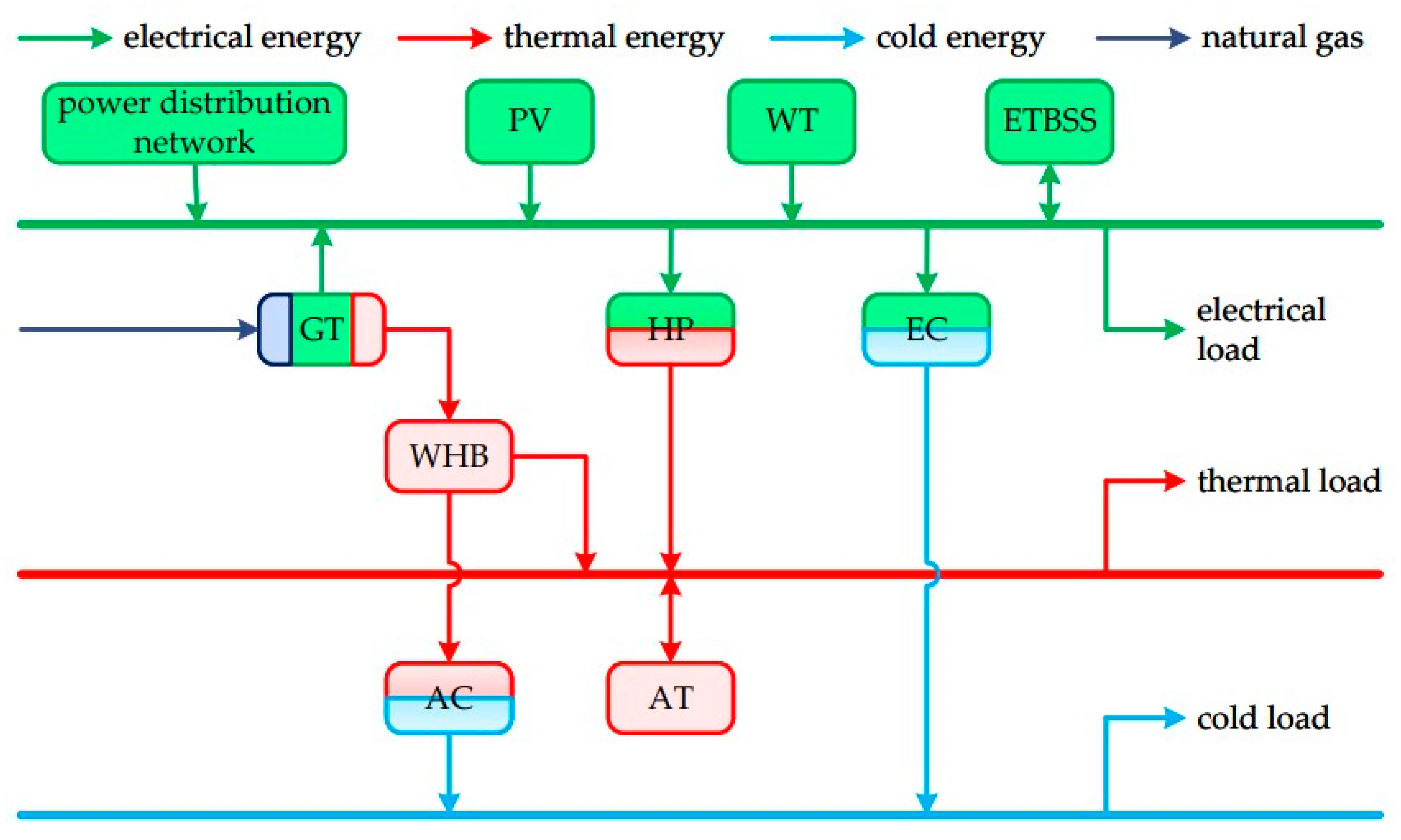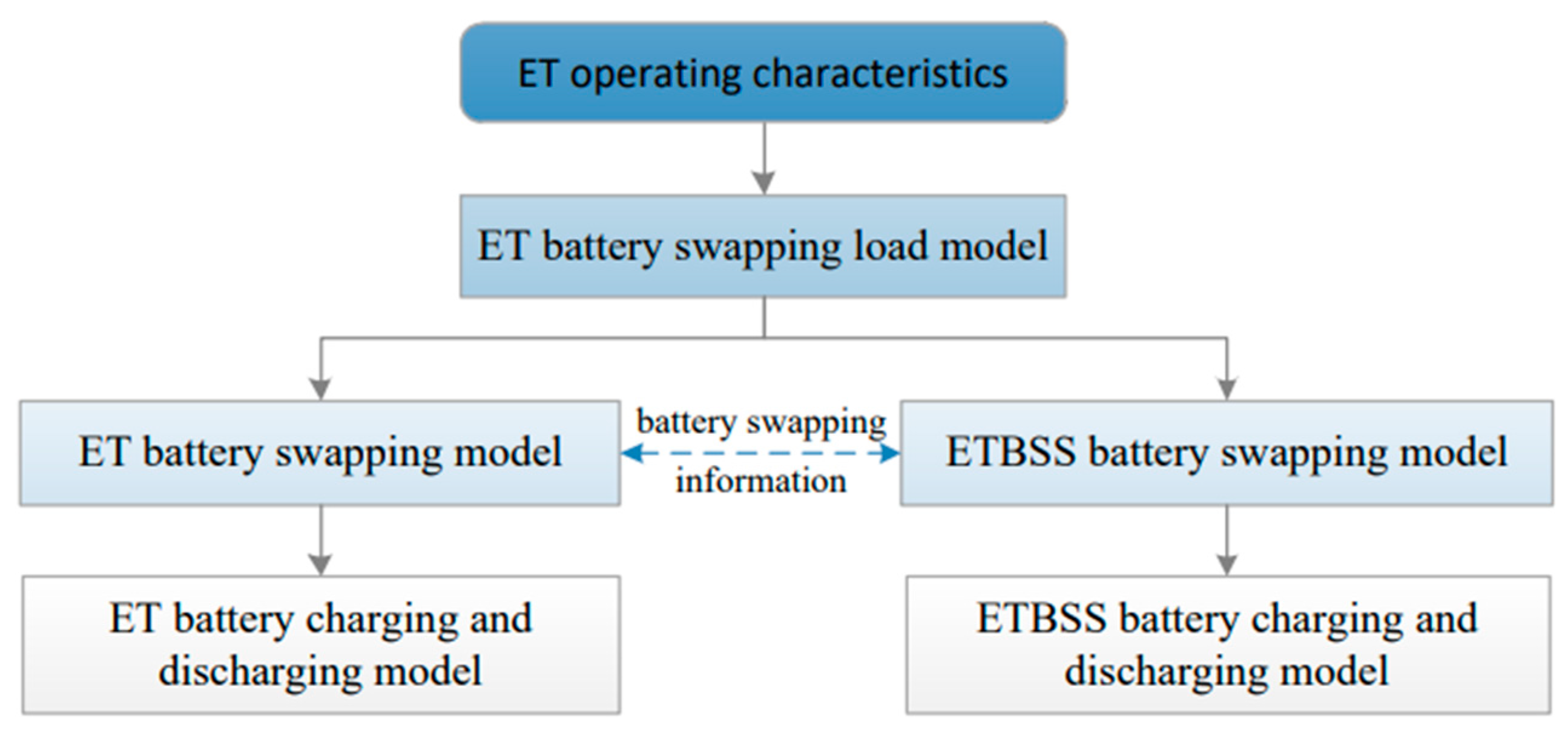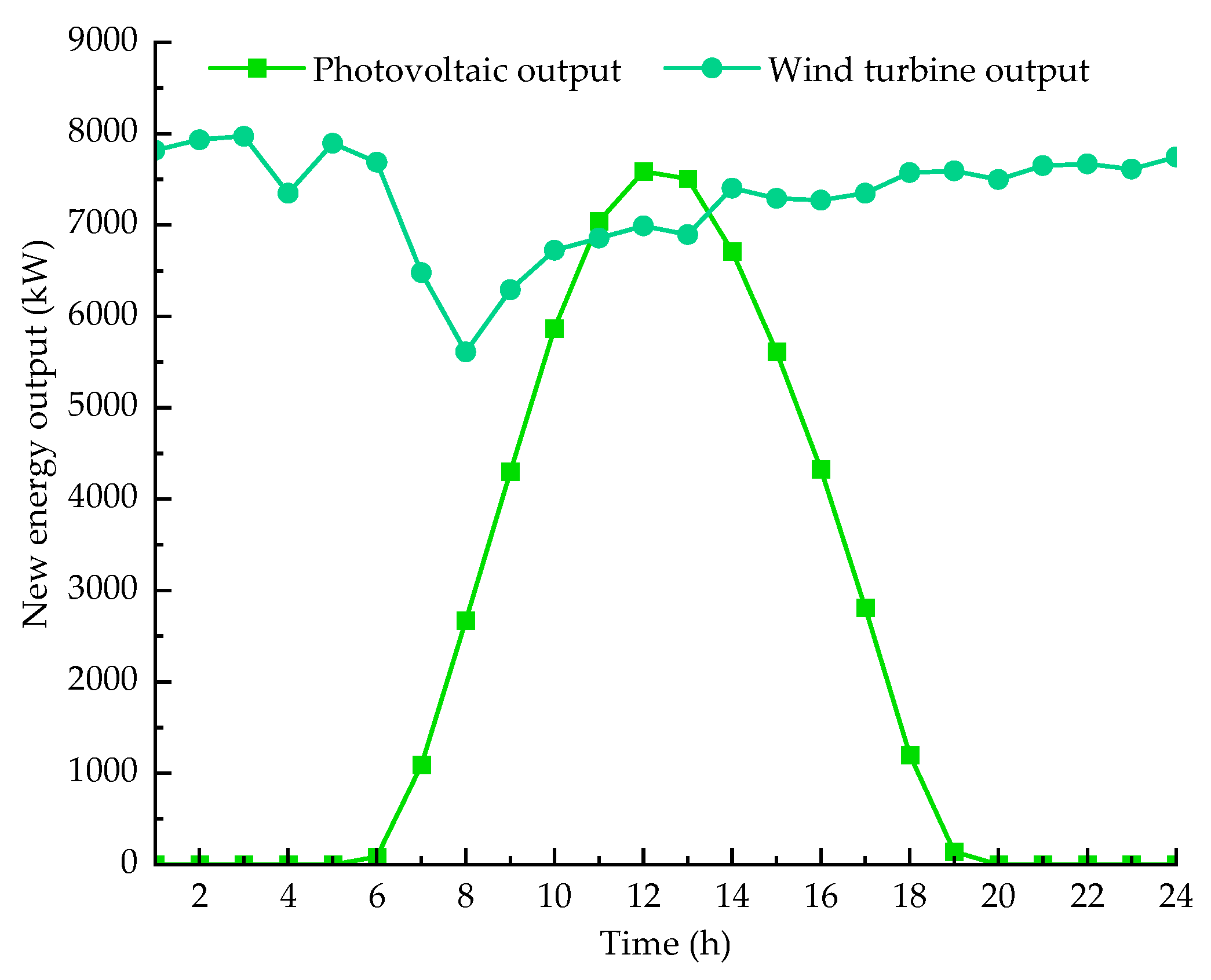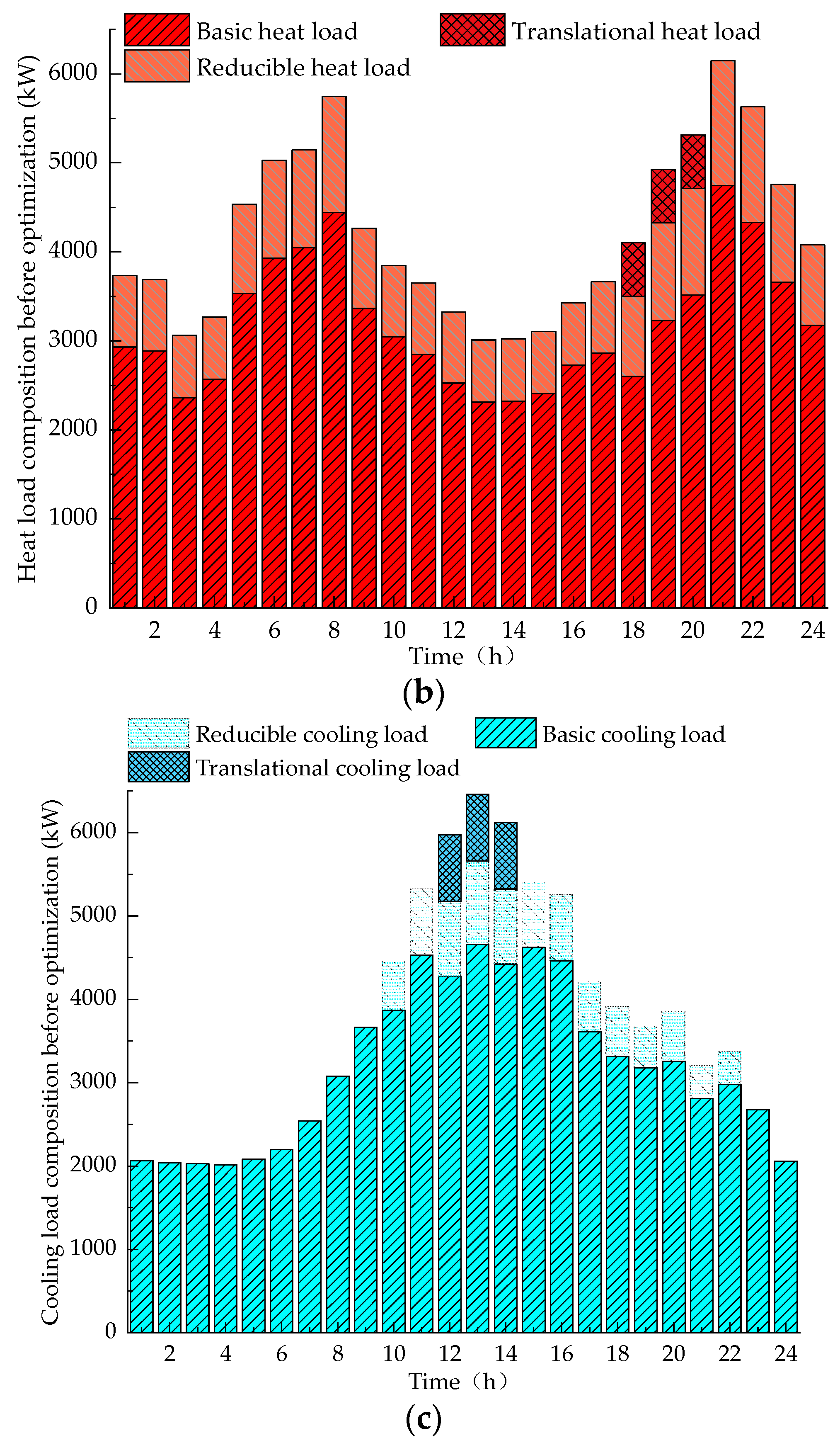Optimized Scheduling of an Integrated Energy System with an Electric Truck Battery Swapping Station
Abstract
:1. Introduction
2. IES with an ETBSS Structure and Model Building
2.1. ET and ETBSS Models
- (1)
- The ET battery is the same model as the battery in the ETBSS, and the ET can complete a round-trip operation and battery swap within a period of time.
- (2)
- The electricity of the ETBSS’s batteries at the initial moment of the battery swapping period should meet the power demands of ET users during the period, and the batteries swapped by the ETs can only start charging and discharging in the next period; that is, the impact of ET arrival time on the ETBSS charge and discharge plan is not considered.
- (3)
- A charge and discharge chamber can only charge or discharge a battery in a certain period of time.
- (4)
- The number of battery storage locations in the ETBSS is the same as the number of batteries in the ETBSS.
2.1.1. Modeling of ET Battery Swapping Load
2.1.2. ET Battery Swapping Model
2.1.3. ETBSS Battery Swapping Model
2.1.4. ETBSS Battery Charging and Discharging Model
2.1.5. ET Battery Charging and Discharging Model
2.2. GT Model with Adjustable Thermoelectric Ratio
2.3. WHB Running Model
3. IES with an ETBSS Optimization Scheduling Model
3.1. Objective Function
3.2. Constraints
3.2.1. Energy Balance Constraints
3.2.2. Power Constraints of Energy Conversion Equipment
3.2.3. Energy Trading Constraints
3.3. Model Solving
4. Analysis of Simulation Example
4.1. Basic Data
4.2. Influence of ETBSS-Optimized Scheduling on IES Operation
5. Conclusions
- Under the premise of meeting the transportation tasks of ETs, the energy demands of ETs with integrated charging and battery swapping running on a fixed line can be adjusted within a certain range.
- Combined with the above simulation examples, it can be seen that an IES that adopts integrated charging and battery swapping in ETs and orderly charging and discharging operation modes in the ETBSS can better play an energy storage role for the ETBSS and ET batteries on the basis of meeting the energy supply requirements of ETs, as well as coordinate the electrical, thermal and cooling energies of the IES; this makes the economics of the IES better, as well as the abilities to absorb new energy and reduce carbon emissions. In the above simulation example, compared with the IES that adopts the battery swapping mode in ETs and the unordered charge mode in the ETBSS, the IES that adopts the integrated charge and battery swapping mode in ETs and the orderly charge and discharge modes in the ETBSS reduces the operating costs by CNY 819, reduces carbon emissions by 414 kg, improves the utilization rate of WP and PV by 0.3%, and fully utilizes WT and PV.
Author Contributions
Funding
Data Availability Statement
Conflicts of Interest
References
- Bai, L.; Li, F.; Cui, H.; Jiang, T.; Sun, H.; Zhu, J. Interval optimization based operating strategy for gas-electricity integrated energy systems considering demand response and wind uncertainty. Appl. Energy 2016, 167, 270–279. [Google Scholar] [CrossRef]
- Liu, Z.; Liu, R.; Liang, N.; Liu, X. Day-ahead optimal economic dispatching strategy for micro energy-grid with P2G. Trans. China Electrotech. Soc. 2020, 35, 535–543. [Google Scholar]
- Chen, J.; Hu, Z.; Chen, Y.; Chen, J.; Chen, W.; Gao, M.; Lin, M.; Du, Y. Thermoelectric optimization of integrated energy system considering ladder-type carbon trading mechanism and electric hydrogen production. Electr. Autom. Equip. 2021, 41, 48–55. [Google Scholar]
- Zhang, J.; Kong, D.; He, Y.; Fu, X.; Zhao, X.; Yao, G.; Teng, F.; Qin, Y. Bi-layer energy optimal scheduling of regional integrated energy system considering variable correlations. Int. J. Electr. Power Energy Syst. 2023, 148, 108840. [Google Scholar] [CrossRef]
- Wang, Y.; Zhou, M.; Zhang, F.; Zhang, Y.; Ma, Y.; Dong, H.; Zhang, D.; Liu, L. Chinese grid investment based on transmission and distribution tariff policy: An optimal coordination between capacity and demand. Energy 2021, 219, 119589. [Google Scholar] [CrossRef]
- Hao, H.; Zhou, B.; Zhang, X. Research of integrated energy system optimization carbon trading and demand response. Northeast Power Technol. 2022, 43, 32–37+43. [Google Scholar]
- Chen, W.; Ran, Y.; Han, Y.; Li, Q. Optimal scheduling of regional integrated energy systems under two-stage power to gas. J. Southwest Jiaotong Univ. 2023, 58, 1221–1230. [Google Scholar]
- Zhu, X.; Sun, Y.; Yang, J.; Dou, Z.; Li, G.; Xu, C.; Wen, Y. Day-ahead energy pricing and management method for regional integrated energy systems considering multi-energy demand responses. Energy 2022, 251, 123914. [Google Scholar] [CrossRef]
- Li, Y.; Zou, Y.; Tan, Y.; Cao, Y.; Liu, X.; Shahidehpour, M.; Tian, S.; Bu, F. Optimal stochastic operation of integrated low-carbon electric power, natural gas, and heat delivery system. IEEE Trans Sustain. Energy 2018, 9, 273–283. [Google Scholar] [CrossRef]
- Wang, R.; Gu, W.; Wu, Z. Economic and optimal operation of a combined heat and power microgrid with renewable energy resources. Power Syst. Autom. 2011, 35, 22–27. [Google Scholar]
- Azizipanah-Abarghooee, R.; Niknam, T.; Bina, M.A.; Zare, M. Coordination of combined heat and power-thermal-wind-photovoltaic units in economic load dispatch using chance-constrained and jointly distributed random variables methods. Energy 2015, 79, 50–67. [Google Scholar] [CrossRef]
- Zhu, J.; Liu, Y.; Xu, L.; Jiang, Z.; Ma, C. Robust day–ahead economic dispatch of microgrid with combined heat and power system considering wind power consumption. Power Syst. Autom. 2019, 43, 40–48. [Google Scholar]
- Peng, C.; Xie, P.; Zhan, J.; Sun, H. Robust economic dispatch of microgrid using improved bacterial foraging algorithm. Power Grid Technol. 2014, 38, 2392–2398. [Google Scholar]
- Wang, C.; Yan, C.; Li, G.; Liu, S.; Bie, Z. Risk assessment of integrated electricity and heat system with independent energy operators based on Stackelberg game. Energy 2020, 198, 117349. [Google Scholar] [CrossRef]
- Xu, X. Research on Short-Term Load Forecasting of Electric Vehicle Charging Station. Master’s Thesis, North China Electric Power University, Baoding, China, 2016. [Google Scholar]
- Liu, W.; Xu, X.; Zhou, X. Daily load forecasting based on SVM for electric bus charging station. Electr. Power Autom. Equip. 2014, 34, 41–47. [Google Scholar]
- Zhang, X.; Chan, K.W.; Li, H.; Wang, H.; Qiu, J.; Wang, G. Deep-learning-based probabilistic forecasting of electric vehicle charging load with a novel Queuing model. IEEE Trans. Cybern. 2021, 51, 3157–3170. [Google Scholar] [CrossRef] [PubMed]
- Quevedo, P.M.; Muñoz-Delgado, G.; Contreras, J. Impact of electric vehicles on the expansion planning of distribution systems considering renewable energy, storage, and charging stations. IEEE Trans. Smart Grid 2019, 10, 794–804. [Google Scholar] [CrossRef]
- Fan, M.; Zhang, Y.; Kang, J.; Yu, Y. Fuzzy clustering-markov chain based load forecasting modeling for battery-swap stations. Electr. Power Constr. 2023, 44, 63–71. [Google Scholar]
- Yan, X.; Lu, J.; Jia, J.; Qi, B.; Xu, X.; Li, Y. A multi-objective optimal dispatch of microgrid with cyclic swapping loads and charging stations. J. North China Electr. Power Univ. 2022, 7, 1–12. [Google Scholar]
- Luo, J.; Zhang, W.; Wang, G.; Zhang, S. An electric vehicle charging demand forecast model based on trip chain data. J. Chongqing Univ. Technol. Nat. Sci. 2020, 34, 1–8. [Google Scholar]
- Jackson, D.; Cao, Y.; Beil, I. Bi-level optimization framework for heavy-duty electric truck charging station design. In Proceedings of the 2022 IEEE Transportation Electrification Conference & Expo (ITEC), Anaheim, CA, USA, 15–17 June 2022; pp. 563–568. [Google Scholar]
- Jia, S.; Kang, X.; Cui, J.; Tian, B.; Zhang, J.; Xiao, S. Multi-layer coordinated optimization of integrated energy system with electric vehicles based on feedback correction. Front. Energy Res. 2022, 10, 1008042. [Google Scholar] [CrossRef]
- Jia, S.; Kang, X.; Cui, J.; Tian, B.; Xiao, S. Hierarchical stochastic optimal scheduling of electric thermal hydrogen integrated energy system considering electric vehicles. Energies 2022, 15, 5509. [Google Scholar] [CrossRef]
- Fu, Z.; Zhu, W.; Zhu, J.; Yuan, Y.; Feng, Y.; Wang, H. Battery swapping demand prediction of electric taxis and charging optimization strategy of battery swapping station under “electric taxi-battery-traffic-station” interconnection. Electr. Power Autom. Equip. 2022, 42, 116–124. [Google Scholar]
- Cai, Z.; Shu, H.; Shan, J. Optimal dispatching strategy for battery swapping of electric bus cluster considering operation cost. Autom. Electr. Power Syst. 2022, 46, 205–217. [Google Scholar]
- Razi, R.; Hajar, K.; Hably, A.; Mehrasa, M.; Bacha, S.; Labonne, A. Assessment of predictive smart charging for electric trucks: A case study in fast private charging stations. In Proceedings of the 2022 IEEE International Conference on Electrical Sciences and Technologies in Maghreb (CISTEM), Tunis, Tunisia, 26–28 October 2022; Volume 4, pp. 1–6. [Google Scholar]
- Tian, W.; He, J.; Jiang, J.; Niu, L.; Wang, X. Multi-objective optimization of charging dispatching for electric vehicle battery swapping station based on adaptive mutation particle swarm optimization. Power Syst. Technol. 2012, 36, 25–29. [Google Scholar]
- Meng, X.; Mi, Z.; Wang, J.; Dong, K.; Cai, X.; Han, S. An economic and optimal dispatch model for battery swapping stations containing photovoltaics considering variable-speed charging mechanism. Zhejiang Electric Power 2022, 41, 35–41. [Google Scholar]
- Liu, H.; Shen, H.; Hu, W.; Ji, L.; Li, J.; Yu, Y. Load forecast of electric trucks aggregation based on higher-order markov chains. Electr. Power 2023, 8, 1203–1207. [Google Scholar]
- Li, Y.; Zhao, Y.; Cui, Y.; Zhong, W.; Li, H. Low-carbon economic dispatching of battery swapping station and wind power-carbon capture virtual power plant considering charging and discharging strategy. Electr. Power Autom. Equip. 2023, 43, 27–36. [Google Scholar]
- Luo, H.; Zhang, X.; Li, Y.; Yu, H.; Peng, F.; Li, J. Low carbon economic scheduling of virtual power plants with wind power, carbon capture, charge and change station considering charge discharge strategy. Mod. Electr. Power 2023, 8, 1–10. [Google Scholar]
- Jiao, H.; Yu, A.; Wang, Y. Low-carbon economic dispatch of an integrated energy system considering battery swapping stations. Energy Storage Sci. Technol. 2023, 12, 3254–3264. [Google Scholar]
- Lin, S.; Liu, C.; Shen, Y.; Li, F.; Li, D.; Fu, Y. Stochastic planning of integrated energy system via Frank-Copula function and case reduction. IEEE Trans. Smart Grid 2021, 13, 202–212. [Google Scholar] [CrossRef]
- Wu, F.; Liu, X.; Sun, Y.; Chen, N.; Yuan, T.; Gao, B. Game optimization strategy for multiple parks based on combined cooling heating and power. Autom. Electr. Power Syst. 2018, 42, 68–75. [Google Scholar]
- Zhang, E.; Tai, N.; Chen, Y.; Yao, W.; Huang, W.; Zhao, S. A coordination strategy to smooth power fluctuation of distributed generation in integrated energy system based on virtual energy storage. Power Gener. Technol. 2020, 41, 30–40. [Google Scholar]
- Cheng, S.; Huang, T.; Wai, R. Multi-time-scale optimal scheduling of CCHP microgrid with ice-storage air-conditioning. Autom. Electr. Power Syst. 2019, 43, 30–38. [Google Scholar]
- Jiang, W.; Yan, Z.; Cao, J.; Xu, X. Multi-objective comprehensive optimal dispatch of energy hub considering flexible load. Electr. Meas. Instrum. 2018, 55, 31–39. [Google Scholar]
- Cui, Y.; Zeng, P.; Zhong, W.; Cui, W.; Zhao, Y. Low-carbon economic dispatch of electricity-gas-heat integrated energy system based on ladder-type carbon trading. Electr. Power Autom. Equip. 2021, 41, 10–17. [Google Scholar]
- Xue, K.; Chu, Y.; Ling, Z.; Li, Z. Low-carbon economic optimal dispatch of integrated energy system considering flexible load. Renew. Energy Resour. 2019, 37, 1206–1213. [Google Scholar]
- Wang, Z.; Shi, Y.; Tang, Y.; Men, X.; Cao, J.; Wang, H. Low carbon economy operation and energy efficiency analysis of integrated energy systems considering LCA energy chain and carbon trading mechanism. CSEE J. Power Energy Syst. 2019, 39, 1614–1626+1858. [Google Scholar]






| Device Type | Parameter | Numerical Value |
|---|---|---|
| ET | ET quantity | 3 |
| Run time (h) | 8:00~12:00 | |
| Number of round trips (times) | 4 | |
| A round trip consumes the battery SOC | 32% | |
| Maximum average charging power () | 240 | |
| Maximum average discharge power () | 240 | |
| ETBSS | Number of batteries | 3 |
| Number of charge and discharge equipment | 3 | |
| Maximum number of batteries swapped in a period | 3 | |
| Maximum average charging power () | 240 | |
| Maximum average discharge power () | 240 | |
| Battery charging efficiency | 0.97 | |
| Battery discharging efficiency | 0.95 | |
| Operating cost () | 0.06 | |
| Maintenance cost () | 0.49 | |
| Battery | Battery capacity () | 281.92 |
| Battery charge and discharge loss cost () | 0.135 | |
| AT | AT capacity () | 1000 |
| Initial thermal energy () | 200 | |
| Maximum average power of charging and releasing heat () | 300 | |
| Thermal energy storage efficiency | 0.95 | |
| Thermal energy release efficiency | 0.9 | |
| Coefficient of thermal energy loss | 0.01 | |
| Utilization range of thermal energy () | 200∼950 | |
| Operating cost () | 0.016 | |
| Maintenance cost () | 0.6 | |
| GT | GT capacity () | 8000 |
| Efficiency | 0.8 | |
| Upper limit of climbing power () | 4000 | |
| Operating cost () | 0.04 | |
| Maintenance cost () | 0.72 | |
| Thermoelectric ratio range | 1.22~2.33 | |
| WHB | WHB capacity () | 5000 |
| Efficiency | 0.8 | |
| Upper limit of climbing power () | 2500 | |
| Operating cost () | 0.04 | |
| Maintenance cost () | 0.72 | |
| AC | AC capacity () | 6000 |
| COP | 1.1 | |
| Upper limit of climbing power () | 3000 | |
| Operating cost () | 0.05 | |
| Maintenance cost () | 0.8 | |
| HP | HP capacity () | 5200 |
| COP | 4.2 | |
| Upper limit of climbing power () | 2600 | |
| Operating cost () | 0.035 | |
| Maintenance cost () | 0.72 | |
| EC | EC capacity () | 5200 |
| COP | 3.5 | |
| Upper limit of climbing power () | 2600 | |
| Operating cost () | 0.04 | |
| Maintenance cost () | 0.72 | |
| WT | Operating cost () | 0.07 |
| Maintenance cost () | 0.48 | |
| Abandoning wind energy penalty costs () | 0.2 | |
| PV | Operating cost () | 0.039 |
| Maintenance cost () | 0.5 | |
| Abandoning light energy penalty costs () | 0.2 |
| Parameter | Numerical Value |
|---|---|
| GT carbon quota () | 0.102 |
| Carbon quota for purchasing electrical energy () | 0.68 |
| Conversion coefficient for carbon quota for electricity generation and carbon quota for heat generation of GT | 1.67 |
| Carbon trading base price () | 0.06 |
| Length of carbon emission interval () | 2000 |
| Price growth rate | 0.5 |
| Carbon emissions from natural gas combustion () | 1.964 |
| The actual carbon emissions of electrical energy purchased () | 1.08 |
| Parameter | Numerical Value |
|---|---|
| Average purchasing electrical power range () | 0~5000 |
| Average rate of natural gas consumption () | 0~1000 |
| IES Power Load Status | Time (h) | Electricity Price () |
|---|---|---|
| Valley load | 23:00~8:00 | 0.38 |
| Plain valley load | 8:00~12:00; 15:00~19:00 | 0.68 |
| Peak load | 12:00~15:00; 19:00~23:00 | 1.2 |
| Load Type | Parameter | Numerical Value |
|---|---|---|
| Translatable electrical load | Time of duration (h) | 3 |
| Translatable time period | 5:00~21:00 | |
| Offset cost () | 0.2 | |
| Translatable heat load | Time of duration (h) | 3 |
| Translatable time period | 5:00~21:00 | |
| Offset cost () | 0.1 | |
| Translatable cooling load | Time of duration (h) | 3 |
| Translatable period | 5:00~21:00 | |
| Offset cost () | 0.1 | |
| Transferable electrical load | Minimum duration (h) | 2 |
| Range of transferable load power (percentage of total transferable load power) | 20%~100% | |
| Transferable time period | 4:00~22:00 | |
| Offset cost () | 0.3 | |
| Reducible electrical load | Duration range (h) | 2~5 |
| Maximum number of cuts (1 time period means 1 time) | 8 | |
| Reducible period | 5:00~22:00 | |
| Offset cost () | 0.4 | |
| Reducible heat load | Duration range (h) | 2~5 |
| Maximum number of cuts (1 time period means 1 time) | 8 | |
| Reducible period | 6:00~22:00 | |
| Offset cost () | 0.2 | |
| Reducible cooling load | Duration range (h) | 2~5 |
| Maximum number of cuts (1 time period means 1 time) | 8 | |
| Reducible period | 11:00~19:00 | |
| Offset cost () | 0.2 |
| Case | ET Operating Mode | ETBSS Running Mode |
|---|---|---|
| Case 1 | Integrated charging and battery swapping | Ordered charge and discharge |
| Case 2 | Battery swapping | Ordered charge and discharge |
| Case 3 | Battery swapping | Ordered charging |
| Case 4 | Battery swapping | Unordered charging |
| Case 5 | Battery swapping | Use spare batteries and charge overnight |
| Case | Total Cost (CNY) | Amount of Carbon Emissions | Wind Electricity and Photovoltaic Utilization Rate |
|---|---|---|---|
| Case 1 | 105,294 | 6178 | 100% |
| Case 2 | 105,900 | 6489 | 99.87% |
| Case 3 | 106,059 | 6592 | 99.70% |
| Case 4 | 106,113 | 6592 | 99.70% |
| Case 5 | 106,497 | 6700 | 99.43% |
| The Operational Model of ETs and ETBSSs with Flexible Charging and Discharging | Other EV Charging and Battery Swapping Station Models |
|---|---|
| Each battery is managed individually. | Most batteries are classified and then managed in clusters. |
| The energy demands of ETs can be obtained according to the running characteristics of ETs; on the premise of meeting the transportation demands of ETs, the load can be adjusted to some extent according to the demand on the IES. | The energy supply requirements of the most EVs are predicted based on the EV operation law, and almost all of them are not adjustable. |
| The battery does not need to be fully charged when the battery is swapped. | The battery does not take part in a battery swapping until it is fully charged. |
| The charging and discharging behavior of the battery can be interrupted. | The charging and discharging behavior of the battery cannot be interrupted. |
| The charging and discharging power of the battery is variable. | Most batteries are charged and discharged at constant power. |
| When an ET is working, the battery swapping mode is adopted to improve the working efficiency of the ET. When an ET is idle, the ET accesses the ETBSS to participate in IES scheduling and improve the electrical energy storage capacity of the IES. | Most EVs use a single means for energy supply, charging, or battery swapping. |
| Calculations of the optimization model are substantial, and the optimization model takes a long time to solve. | Calculations of the optimization model are small, and the optimized operation scheme can be obtained quickly. |
Disclaimer/Publisher’s Note: The statements, opinions and data contained in all publications are solely those of the individual author(s) and contributor(s) and not of MDPI and/or the editor(s). MDPI and/or the editor(s) disclaim responsibility for any injury to people or property resulting from any ideas, methods, instructions or products referred to in the content. |
© 2023 by the authors. Licensee MDPI, Basel, Switzerland. This article is an open access article distributed under the terms and conditions of the Creative Commons Attribution (CC BY) license (https://creativecommons.org/licenses/by/4.0/).
Share and Cite
Liu, B.; Chen, J.; Zhang, N.; Liu, J.; Zhang, Y.; Bao, H.; Liu, L.; Chen, K. Optimized Scheduling of an Integrated Energy System with an Electric Truck Battery Swapping Station. Processes 2024, 12, 84. https://doi.org/10.3390/pr12010084
Liu B, Chen J, Zhang N, Liu J, Zhang Y, Bao H, Liu L, Chen K. Optimized Scheduling of an Integrated Energy System with an Electric Truck Battery Swapping Station. Processes. 2024; 12(1):84. https://doi.org/10.3390/pr12010084
Chicago/Turabian StyleLiu, Bin, Jie Chen, Nan Zhang, Jun Liu, Yuchao Zhang, Hongyin Bao, Lili Liu, and Kang Chen. 2024. "Optimized Scheduling of an Integrated Energy System with an Electric Truck Battery Swapping Station" Processes 12, no. 1: 84. https://doi.org/10.3390/pr12010084





